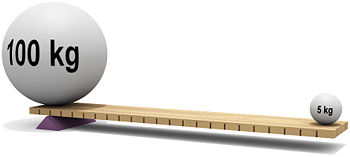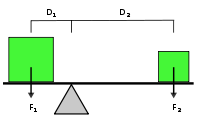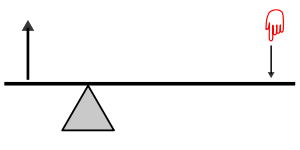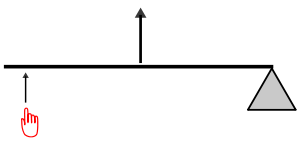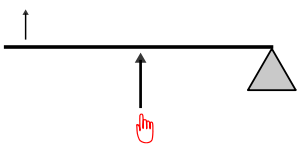Difference between revisions of "Lever" - New World Encyclopedia
| Line 95: | Line 95: | ||
*[[Engineering mechanics]] | *[[Engineering mechanics]] | ||
*[[Simple machine]] | *[[Simple machine]] | ||
| + | |||
| + | == Notes == | ||
| + | <references/> | ||
== References == | == References == | ||
Revision as of 19:33, 20 June 2007
In physics, a lever (from French lever, "to raise", cf. a levant) is a rigid object that is used with an appropriate fulcrum or pivot point to multiply the mechanical force that can be applied to another object. The lever allows less effort to be expended to move an object a greater distance. This is also termed mechanical advantage, and is one example of the principle of moments.
<<Summarize some of the familiar uses of the 3 types of levers here.>>
History
<<If possible, please add some more info about the history of levers.>>
The earliest remaining writings regarding levers date from the third century B.C.E. and were provided by Archimedes—behind his famous remark Give me the place to stand, and I shall move the earth stands a correct mathematical principle of levers (quoted by Pappus of Alexandria) and of the various methods possibly used by builders.
Theory of Operation
Levers are one class of the six types of simple machines. The principle of leverage can be derived using Newton's laws of motion, and modern statics. It is important to note that the amount of work done is given by force times distance.
To use a lever to lift a certain unit of weight with an effort of half a unit, the distance from the fulcrum of the spot where force is applied must be twice the distance between the weight and the fulcrum. For example, to halve the effort of lifting a weight resting 1 metre from the fulcrum, we would need to apply force 2 metres from the other side of the fulcrum. The amount of work done is always the same and independent of the dimensions of the lever (in an ideal lever). The lever only allows one to trade effort for distance.[1]
The three classes of levers
There are three classes of levers representing variations in the location of the fulcrum and the input and output forces.
First-class levers
A first-class lever is a lever in which the fulcrum is located in between the input force and the output force. In operation, a force is applied (by pulling or pushing) to a section of the bar, which causes the lever to swing about the fulcrum, overcoming the resistance force on the opposite side. The fulcrum is the center of the lever on which the bar (as in a seesaw) lays upon. This supports the effort arm and the load.
Examples:
- Seesaw (also known as a teeter-totter)
- Crowbar
- Spud bar (moving heavy objects)
- Pliers (double lever)
- Scissors (double lever)
- Wheel and axle because the wheel's motions follows the fulcrum, load arm, and effort arm principle
- Trebuchet, an upside down example of the above picture
- Oars, when used for moving or splashing water
- Can opener and bottle opener
- Bicycle hand brakes
- Hand trucks are L-shaped but works on the same principle on the wheel as a fulcrum
- Hammer, when pulling a nail with the hammer's claw
- Tweezers that are shaped like scissors work as double levers
- Shoehorn
- Beam engine although here the aim is just to change the direction in which the applied force acts, since the fulcrum is normally in the centre of the beam (ie D1 = D2).
Second-class levers
In a second class lever the input is located to the far side of the bar, the output is located in the middle of the bar, and the fulcrum is located on the side of the bar opposite to the input. Examples:
- Nutcracker
- Door
- Crowbar
- Stapler
- Diving Board
- Wrench
- Dental Elevator
- Can Opener
- Canoe Paddle
- Wheelbarrow
- Oars, when the boat is the resistance moving the same direction as the force and using water as the fulcrum
Third-class levers
It is to be noted that for this class of levers, the input effort is higher than the output load, which is different from the first-class and second-class levers. However, also notice that the input effort moves through a shorter distance than the load. Thus it still has its uses in making certain tasks easier to do. Third class lever uses the effort in the center, while the output load is on one side, raising the load on the opposite end.
Examples:
- Human Arm
- Tweezers
- Slings, trebuchets, and fishing rods
- Various tools, such as a hoe or scythe
- The main body of a pair of nail clippers, in which the handle exerts the incoming force
- Shovel
- Broom
- Staple Remover
- Hockey Stick
- The Human Mandible
- Boat paddle
- Baseball bat
- Mousetrap
- Door
Mnemonics
- A mnemonic for remembering the three classes of levers is the word flex, where the letters f-l-e represent the fulcrum, the load, and the effort as being between the other two, in the first-class lever, the second-class lever, and the third-class lever respectively. (To relate the mnemonic to the above diagrams, note that: the "fulcrum" is represented by the triangle, the "effort" is denoted by the arrow with a hand symbol, and the "load" is the other arrow.)
- Alternatively, the term 'Frogs lay eggs' can also be use in the similar manner. Some people remember the word 'elf', which sorts the classes from the third to first.
- To remember what the different classes of levers look like, another mnemonic is "fre 123" In a 1st class lever the fulcrum is in the middle, 2nd class the resistance is in the middle, and 3rd class the effort is in the middle of it.
See also
- Engineering mechanics
- Simple machine
Notes
- ↑ Resistance distance is the distance from the resistance (on a lever) to the fulcrum.
ReferencesISBN links support NWE through referral fees
<<We need at least 3 reliable references here, properly formatted.>>
External links
- DiracDelta.co.uk Levers and examples
Credits
New World Encyclopedia writers and editors rewrote and completed the Wikipedia article in accordance with New World Encyclopedia standards. This article abides by terms of the Creative Commons CC-by-sa 3.0 License (CC-by-sa), which may be used and disseminated with proper attribution. Credit is due under the terms of this license that can reference both the New World Encyclopedia contributors and the selfless volunteer contributors of the Wikimedia Foundation. To cite this article click here for a list of acceptable citing formats.The history of earlier contributions by wikipedians is accessible to researchers here:
The history of this article since it was imported to New World Encyclopedia:
Note: Some restrictions may apply to use of individual images which are separately licensed.
